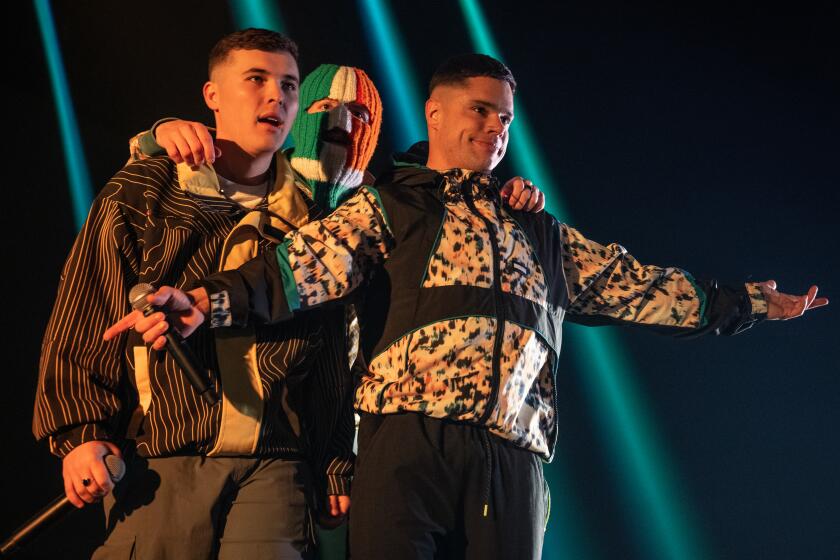Monterey Jazz’s Lyons Has His 15th Sellout
- Share via
MONTEREY — Jimmy Lyons, president, general manager and chief honcho of the Monterey Jazz Festival, is on to a good thing.
For 15 years, the festival, which opens its 32nd season tonight in an idyllic setting at the Monterey County Fairgrounds, has sold out all five of its Friday-Sunday, 7,000-seat concerts--and usually in advance.
And this without the more popular jazz/fusion artists like Kenny G, Spyro Gyra or Lee Ritenour. In two words, Monterey is not trendy.
“I’m not fond of fusion or the other new parts,” said Lyons, a former disc jockey who, along with the late San Francisco Chronicle critic Ralph J. Gleason and others, started the festival in 1958. “Our philosophy is to hold to the art form known as jazz straight-ahead, which includes blues, mainstream, be-bop and occasionally Latin.”
This year’s lineup stays true to form, with mostly name artists along with a smattering of new or unique acts. The headliners include trumpeters Dizzy Gillespie and Freddie Hubbard, singer Billy Eckstine, pianist Monty Alexander and the big bands of Illinois Jacquet and Bill Holman. Both Gillespie and Holman, the latter in a quintet with drummer Mel Lewis, played the debut festival 31 years ago.
Tonight’s concert is given over to Latin and Brazilian artists like pianist/singer Tania Maria, and during the weekend the festival-goers will also hear Mad Romance, a vocal group from the East Coast and Take 6, the a cappella sextet.
“We always try and branch out, find artists I think might be appealing to people who have not heard them,” Lyons, who is in his early 70s, said of the latter groups, from his office in Monterey.
Some of the newer artists who achieved greater prominence through their appearances at the festival include altoist Ornette Coleman (1959), reedman Charles Lloyd (1967)--with 17-year-old pianist Keith Jarrett in tow--and singer Bobby McFerrin (1984).
Monterey differs from other major festivals in two respects: It was founded as a nonprofit, educational corporation that has donated $1.25 million to music education programs, and it gives over one of its five concerts to high school-age jazz stars.
In the early years of the festival, Sunday afternoons were set aside for commissioned works from major composers like Duke Ellington, Gunther Schuller, J. J. Johnson and Holman, to be played by their own or all-star ensembles.
But in 1971, that changed when Lyons presented “Jazz Today and Tomorrow.” This program spotlighted the California All-Star High School Jazz Band, made up of young players who had won a competition held in the spring, playing compositions by top writers with headlining artists on hand. This year, the youth band, led by Monterey’s musical director, Bill Berry, will play three Gillespie compositions, with the trumpeter as a special guest.
The Sunday concert has become both a Monterey tradition (as has, since 1970, the Saturday afternoon rhythm and blues bash) and Lyons’ favorite event.
“This is where the future of the music lies,” he said. “I think it’s so important because we’re training new artists, and many of them are coming back now as pros.”
These now-pros include Los Angeles-based saxophonists Mark Russo (the Yellowjackets), Eric Marienthal (Chick Corea), keyboardists Patrice Rushen and Rodney Franklin and guitarist Larry Koonse.
All of Monterey’s proceeds go to the education fund, which aids students throughout California, with additional monies coming from the event’s sponsor, MCI Telecommunications. “They’ve helped greatly, donating over $100,000 in the past five years,” said Lyons.
To accommodate the overflow crowds, Lyons a few years ago opened two additional stages on the fairgrounds, so that those without main-arena tickets could still enjoy both the music--many of the headliners perform in these venues--and the festival ambience. These general-admission tickets are available for all three days of the festival.
As to why his event is so successful, Lyons remains puzzled. “It’s so crazy, I don’t know why. I’m just delighted that it is,” he said.
Asked to recall a highlight, Lyons hesitated, then said: “Well, one of them certainly was in the early ‘60s when Carmen McRae was singing with her eyes closed and suddenly this man with a trumpet sneaks up next to her and plays a soft obbligato in her ear and it was Dizzy Gillespie. I wonder whose ear he’ll play in this year?”
More to Read
The biggest entertainment stories
Get our big stories about Hollywood, film, television, music, arts, culture and more right in your inbox as soon as they publish.
You may occasionally receive promotional content from the Los Angeles Times.










